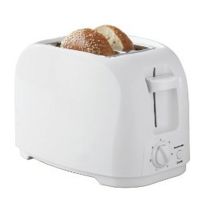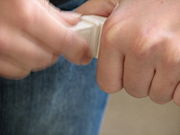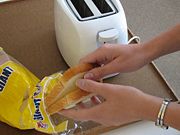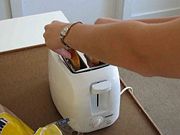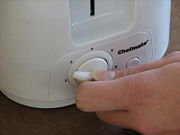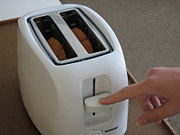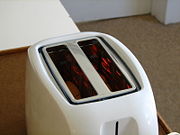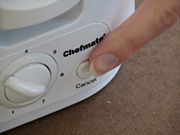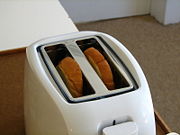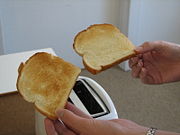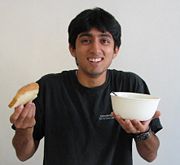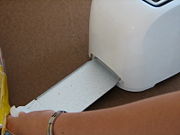Toaster usability study
From DDL Wiki
(Difference between revisions)
Current revision (22:04, 28 September 2008) (view source) m (Usability study moved to Toaster usability study: Page name not specific) |
|||
| (31 intermediate revisions not shown.) | |||
| Line 1: | Line 1: | ||
| - | [[Image: | + | [[Image:toaster.jpg|right|200px]] |
| - | = | + | = Product Use = |
| - | + | Here is a series of photographs depicting a typical customer's interaction with a toaster: | |
| - | + | {| border="0" style="background:transparent;" | |
| + | |- | ||
| + | | | ||
| + | [[Image:Toaster_step1.JPG|192px x 155px|thumb|left|Step 1: Plug in Toaster]] | ||
| + | || | ||
| + | [[Image:Toaster_step2.JPG|192px x 170px|thumb|left|Step 2: Get some type of bread]] | ||
| + | || | ||
| + | [[Image:Toaster_step3.JPG|192px x 155px|thumb|left|Step 3: Place bread in Toaster slots]] | ||
| + | || | ||
| + | [[Image:Toaster_step4.JPG|192px x 155px|thumb|left|Step 4: Set desired toasting amount]] | ||
| + | |} | ||
| - | + | <br /> | |
| - | + | ||
| - | == | + | {| border="0" style="background:transparent;" |
| + | |- | ||
| + | | | ||
| + | [[Image:Toaster_step5.JPG|192px x 155px|thumb|left|Step 5: Pull down handle to start toasting]] | ||
| + | || | ||
| + | [[Image:Toaster_step6.JPG|192px x 170px|thumb|left|Step 6: Wait while bread is toasting to desired level]] | ||
| + | || | ||
| + | [[Image:Toaster_step7.JPG|192px x 155px|thumb|left|Step 7: If you want to stop it early, press cancel]] | ||
| + | || | ||
| + | [[Image:Toaster_step8.JPG|192px x 155px|thumb|left|Step 8: Bread pops up when done or cancel button is pressed]] | ||
| + | |} | ||
| - | |||
| - | |||
| - | |||
| - | |||
| - | |||
| - | + | <br /> | |
| - | + | {| border="0" style="background:transparent;" | |
| + | |- | ||
| + | | | ||
| + | [[Image:Toaster_step9.JPG|192px x 155px|thumb|left|Step 9: a beautiful golden brown ]] | ||
| + | || | ||
| + | [[Image:Toaster_step10.JPG|192px x 170px|thumb|left|Step 10: Enjoy]] | ||
| + | || | ||
| + | [[Image:Toaster_step11.JPG|192px x 155px|thumb|left|Cleaning: remove crumb tray to throw away crumbs fallen in toaster]] | ||
| + | |} | ||
| - | + | = User = | |
| + | For a toaster, users fall into a wide range of people. This includes all ages and economic status, but tend to be limited to people who own or have access to a kitchen. The only major restriction is that toasters requires a user to have a supply of electricity in their household. | ||
| - | + | For this usability study, we sent around a survey and interviewed several people who have interacted with a toaster on a regular basis. The results of this study is shown below. | |
| + | |||
| + | == Needs == | ||
| + | |||
| + | * to toast bread | ||
| + | * low cost | ||
| + | * easy usability | ||
| + | * ability to use a wide variety of bread | ||
| + | |||
| + | == Likes == | ||
| + | |||
| + | * golden brown toast | ||
| + | * cancel button | ||
| + | * well-defined settings | ||
| + | * [http://www.engadget.com/2008/09/12/scan-toaster-puts-the-power-of-miracle-toast-into-the-hands-of/ custom printed toast] | ||
| + | |||
| + | == Annoyances == | ||
| + | |||
| + | * bread gets stuck inside the toaster | ||
| + | * unreliability of toaster settings | ||
| + | * hard to clean | ||
| + | * burned sides of wider bread | ||
| + | * toast doesn't come out of the toaster high enough to grab it. | ||
| + | |||
| + | = Possible Usability Improvements = | ||
| + | |||
| + | From our usability study data we have come up with several possible usability improvements: | ||
| + | |||
| + | * including a cancel button on the toaster to give more user control (already part of our dissected product) | ||
| + | * have toast lifted higher after toasting for easy and pain-free removal | ||
| + | * widening slots after toasting in order to remove wider bread products easily | ||
| + | * allow toaster to fit a wide variety of bread sizes, keeping bread from either not being toasted or being burned on edges. | ||
Current revision
Contents |
Product Use
Here is a series of photographs depicting a typical customer's interaction with a toaster:
User
For a toaster, users fall into a wide range of people. This includes all ages and economic status, but tend to be limited to people who own or have access to a kitchen. The only major restriction is that toasters requires a user to have a supply of electricity in their household.
For this usability study, we sent around a survey and interviewed several people who have interacted with a toaster on a regular basis. The results of this study is shown below.
Needs
- to toast bread
- low cost
- easy usability
- ability to use a wide variety of bread
Likes
- golden brown toast
- cancel button
- well-defined settings
- custom printed toast
Annoyances
- bread gets stuck inside the toaster
- unreliability of toaster settings
- hard to clean
- burned sides of wider bread
- toast doesn't come out of the toaster high enough to grab it.
Possible Usability Improvements
From our usability study data we have come up with several possible usability improvements:
- including a cancel button on the toaster to give more user control (already part of our dissected product)
- have toast lifted higher after toasting for easy and pain-free removal
- widening slots after toasting in order to remove wider bread products easily
- allow toaster to fit a wide variety of bread sizes, keeping bread from either not being toasted or being burned on edges.
